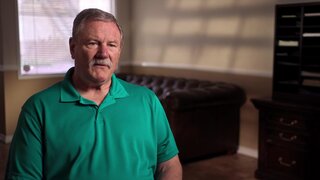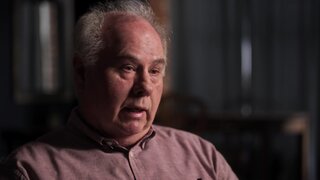Create a free profile to get unlimited access to exclusive videos, breaking news, sweepstakes, and more!
A Love Triangle Leads To The Slaying Of An OC Teen Wrestling Champion
Diego Gonzalez, a 17-year-old high schooler, was found shot to death and burned after he went out for a run one day.
The city of Orange, California is better known for lovely weather than sensational homicides. But on November 10, 2003, youths made the gruesome discovery of the body of a young man near a home construction site.
The victim had been shot and set on fire, according to Dan Salcedo, a retired investigator with the Orange County Sheriff’s Department. A pool of coagulated blood near his body showed that he’d been killed hours earlier.
“The indication is possibly someone who’s trying to cover up the crime scene, hoping that he was going to be burned beyond recognition,” Salcedo told “The Real Murders of Orange County,” streaming now on Oxygen.
As investigators worked to identify the victim, an autopsy revealed that he had been shot in the forehead and in the mouth. The Sheriff’s Department reached out to the public to help name the victim, who was identified as Diego Gonzalez, a 17-year-old high school wrestling champion.
Gonzalez, “a special young man … with a heart of gold,” according to his coach, had left home to go for a run on November 9 and never returned.
Police officers interviewed people who were close to Diego. They began with his on-off girlfriend, a fellow El Modena High School student.
Investigators asked about her whereabouts on the night of November 9. Investigators confirmed her story that she had been with family members and cleared her as a suspect.
Detectives turned to the Gonzalez family for leads. They revealed that there was another woman in Gonzalez’s life.
“Diego had an on-again off-again relationship with a female who was a student who had since graduated from El Modena,” said Salcedo. Her name was Veronica Paz. She and Diego worked together at a grocery store.
Diego and Paz were having “a casual sexual relationship,” said former television reporter Tricia Takasugi, adding that the age difference was striking.
On the evening of November 9, 2003, Diego told his brother that he was going for a run and planned to meet Paz. Investigators spoke with Paz, who said she had no knowledge of where he was and denied that she had called him to meet up. Paz said she spent the evening with her friend, Kim Gomez, and then went home.
Paz also said that she was actually dating Brandan Perry, who’d been a star high school football star and was a year younger than her. During breaks in their relationship she hooked up with Diego. That made Perry jealous, according to sources.
During his interview with detectives, Perry said he met Diego in the summer of 2003 when he was at a party with Paz. He said he had nothing to do with Diego's disappearance and had no idea what happened to him.
Perry said he was with his friend Tommy Medina at his house the night that Diego went missing. He said he went home and remained at his house by himself.
Gomez and Medina corroborated their friends’ alibis. As they broadened their scope investigators learned that when Perry and Diego met at the party in 2003 there was an incident that nearly turned violent. One of Diego’s pals waved a gun. There was bad blood between the two involved with the same woman.
When investigators interviewed Perry again he changed his story. He said that he may have been in the area of the crime scene because of his work detailing cars. Perry was unable to name who his client was.
Police arrested Perry, who immediately asked for a lawyer and cut off any further interrogations. Before police could conduct a search of Perry’s car and home, Paz showed up at the police station unannounced on November 13.
She told a different story than she had originally. Paz said that she was with Perry when Diego called her to hook up on November 9. Paz said that Perry wanted to send a message to Diego.
Paz agreed to pick up Diego and drove with him to a secluded construction site. The two got into the backseat. Perry surprised the two of them and pulled Diego out of the car. She was shocked, she told authorities, when Perry shot Diego twice. They drove away separately.
Paz said that Perry called her and ordered her to return to the crime scene, where they poured gas on Diego’s body to set it on fire. They later joined with Gomez and Medina to coordinate alibis.
Paz’s interview gave police more evidence against Perry. At the same time she incriminated herself and was arrested. “She had a major role in what happened by getting Diego up there knowing well was most probably going to happen that he was going to be shot and killed,” said Salcedo.
As they built the case against Paz and Perry, investigators arrested Gomez and Medina as accessories to murder because of false statements in their initial interviews.
“Tommy Medina tells investigators that this murder had been hatched months before by Veronica,” said Takasugi. Paz and Perry had actually gone out to the desert to test out this gun that they were going to use to kill Diego.”
Gomez told police that Paz wasn’t upset the night of the murder and made it seem like she helped plan the murder. Her motive? She didn’t like being used for casual sex. She felt Gonzalez had been “playing" her as he tried to get back with a former girlfriend, reported the Orange County Register.
Detectives found evidence that Paz bought ammunition from Walmart that matched slugs removed during Diego’s autopsy.
In 2004, Gomez and Medina pleaded guilty to being accessories after the fact to a murder. Medina was sentenced to six days incarceration and three years probation. Gomez was sentenced to six months incarceration and three years of probation, according to “The Real Murders of Orange County.”
Both agreed to testify against Paz and Perry, who’d been charged with murder. On March 28, 2006, just before Perry’s trial was set to begin, he pleaded to first-degree murder so that the death penalty was taken off the table. He also agreed to testify against Paz.
Perry was sentenced to 25 years to life with the possibility of parole. On December 15, 2006, Paz was found guilty of first-degree murder. She was sentenced to 25 years to life in prison with a chance for parole.
In 2008, two years after Paz was convicted of first degree murder, her case was overturned due to a technicality linked to jury instructions. Paz was able to plead guilty to second-degree murder. Her sentence was reduced to 15 years to life.
To learn more about the case watch, “The Real Murders of Orange County,” streaming now on Oxygen.com.
























